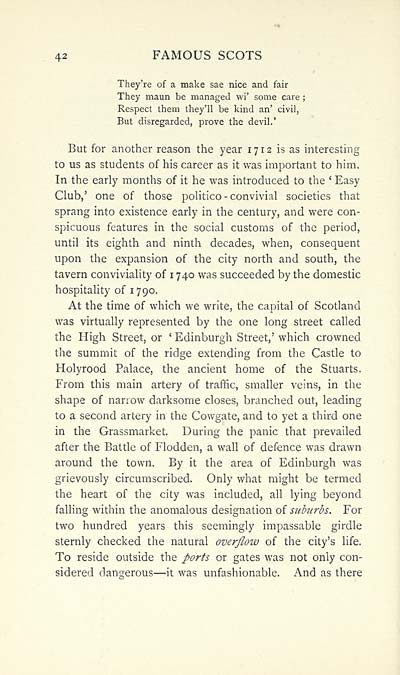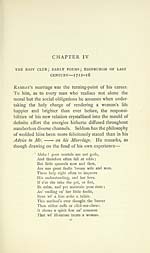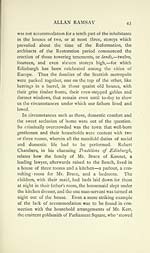Glen Collection of printed music > Printed text > Allan Ramsay
(46) Page 42
Download files
Complete book:
Individual page:
Thumbnail gallery: Grid view | List view

42 FAMOUS SCOTS
They're of a make sae nice and fair
They maun be managed wi' some care ;
Respect them they'll be kind an' civil,
But disregarded, prove the devil.'
But for another reason the year 1712 is as interesting
to us as students of his career as it was important to him.
In the early months of it he was introduced to the ' Easy
Club,' one of those politico - convivial societies that
sprang into existence early in the century, and were con-
spicuous features in the social customs of the period,
until its eighth and ninth decades, when, consequent
upon the expansion of the city north and south, the
tavern conviviaHty of 1740 was succeeded by the domestic
hospitahty of 1790.
At the time of which we write, the capital of Scotland
was virtually represented by the one long street called
the High Street, or ' Edinburgh Street,' which crowned
the summit of the ridge extending from the Castle to
Holyrood Palace, the ancient home of the Stuarts.
From this main artery of traffic, smaller veins, in the
shape of narrow darksome closes, branched out, leading
to a second artery in the Cowgate, and to yet a third one
in the Grassmarket. During the panic that prevailed
after the Battle of Flodden, a wall of defence was drawn
around the town. By it the area of Edinburgh was
grievously circumscribed. Only what might be termed
the heart of the city was included, all lying beyond
falling within the anomalous designation of suburbs. For
two hundred years this seemingly impassable girdle
sternly checked the natural overflow of the city's life.
To reside outside the ports or gates was not only con-
sidered dano-erous — it was unfashionable. And as there
They're of a make sae nice and fair
They maun be managed wi' some care ;
Respect them they'll be kind an' civil,
But disregarded, prove the devil.'
But for another reason the year 1712 is as interesting
to us as students of his career as it was important to him.
In the early months of it he was introduced to the ' Easy
Club,' one of those politico - convivial societies that
sprang into existence early in the century, and were con-
spicuous features in the social customs of the period,
until its eighth and ninth decades, when, consequent
upon the expansion of the city north and south, the
tavern conviviaHty of 1740 was succeeded by the domestic
hospitahty of 1790.
At the time of which we write, the capital of Scotland
was virtually represented by the one long street called
the High Street, or ' Edinburgh Street,' which crowned
the summit of the ridge extending from the Castle to
Holyrood Palace, the ancient home of the Stuarts.
From this main artery of traffic, smaller veins, in the
shape of narrow darksome closes, branched out, leading
to a second artery in the Cowgate, and to yet a third one
in the Grassmarket. During the panic that prevailed
after the Battle of Flodden, a wall of defence was drawn
around the town. By it the area of Edinburgh was
grievously circumscribed. Only what might be termed
the heart of the city was included, all lying beyond
falling within the anomalous designation of suburbs. For
two hundred years this seemingly impassable girdle
sternly checked the natural overflow of the city's life.
To reside outside the ports or gates was not only con-
sidered dano-erous — it was unfashionable. And as there
Set display mode to: Large image | Transcription
Images and transcriptions on this page, including medium image downloads, may be used under the Creative Commons Attribution 4.0 International Licence unless otherwise stated. ![]()
| Special collections of printed music > Glen Collection of printed music > Printed text > Allan Ramsay > (46) Page 42 |
|---|
| Permanent URL | https://digital.nls.uk/91278838 |
|---|
| Description | Scottish songs and music of the 18th and early 19th centuries, including music for the Highland bagpipe. These are selected items from the collection of John Glen (1833 to 1904). Also includes a few manuscripts, some treatises, and other books on the subject. |
|---|
| Description | The Glen Collection and the Inglis Collection represent mainly 18th and 19th century Scottish music, including Scottish songs. The collections of Berlioz and Verdi collected by bibliographer Cecil Hopkinson contain contemporary and later editions of the works of the two composers Berlioz and Verdi. |
|---|

